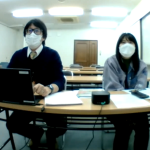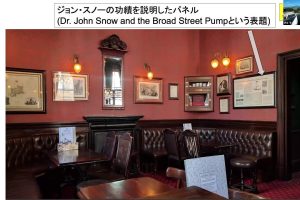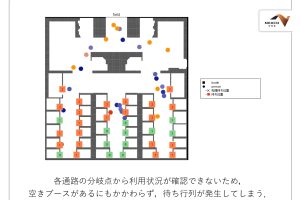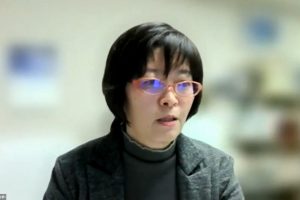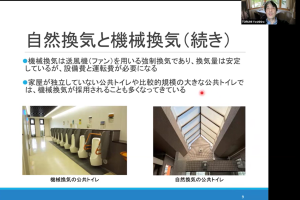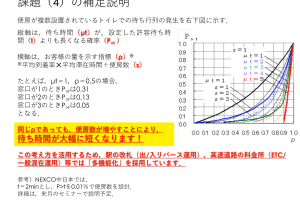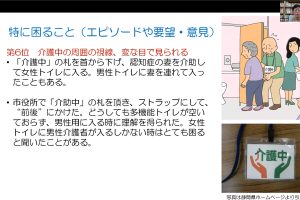Presenters:
Mr. Hironobu Okada (Fuchu City municipal office, Construction Department, Urban Design Division, City Planning Section)
Ms. Shoko Yazaki (Fuchu City municipal office, Economic and Tourism Department, Tourism Division, Tourism Promotion Section)
Organizer:
Yoshihiko Kawauchi, Ph.D., Japan Toilet Association steering committee member, Former professor of Toyo University.
[Introduction of Fuchu City in Hiroshima Prefecture]
(Mr. Okada) Fuchu City, Hiroshima Prefecture, in the ancient time, the Sanyodo, a major arterial highway connecting the capital and Dazaifu in Kyushu, was running, and the Bingo Kokufu, the branch of government covering the area of present eastern part of Hiroshima Prefecture was located. Fuchu city used to be the political, economic, and cultural centre of this region for about 500 years until the Heian periods of the eight centuries. After that, in the Edo period of 17-19 centuries, post towns were established on the Sekishu Kaido which was the main highway connecting between Seto Inland Sea and the Sea of Japan, and then the town became developed.
It has been a distribution center for goods, and many industries developed to process agricultural products gathered from the area from Middle Ages. They were the production of the cotton textiles called Bingo Kasuri, tobacco, woodworking, and the brewing of Fuchu beans paste flourished by the family producing. Today, the main industries of Fuchu City originate from these traditional specialties such as textiles, furniture, beans paste, etc. Recently, there are newly products such as the machinery metals, chemical rubber products, non-ferrous die-cast products, radio control helicopters, etc. 63 companies in the city have been for over 100 years as of 2020.
【Fuchu City Tourism Development Vision】
In June 2020, we have formulated a tourism promotion vision for Fuchu City. We purposed to invite many people from outside the city and abroad to here, “Bingo-Fuchu” to interact and experience. Since the name “Fuchu” exists elsewhere in Japan, we sometimes use the term “Bingo-Fuchu”. This Fuchu City has promoted the tourism industry by making use of local resources such as nature, history, and manufacturing. However, this effort could not lead to an increase in the number of tourists and tourism incomes. Therefore, it becomes to be necessary to plan an effective strategy.
We decided to disseminate information about the many tourism resources in Fuchu City. We warmly welcome tourists, interact with them, and create a promotion system of the hospitality. The tourism promotion vision was formulated in June 2020. Through this vision, we renovated the public toilets with the pedestal style, install multi-purpose toilets, clean facilities, install signs such as the pictograms, etc. and improved our environment in order to appeal to the tourists. It is necessary to gradually improve the toilet environment for the various tourists such as senior citizens, people with disabilities, foreigners, etc.
Now 43.9% of the toilets at the tourist facilities in the city installed the pedestal style toilets, and 26.8% equipped the seats with a warm shower function.
The implementation plan prioritizes the public toilets that are used by many tourists. After that, we plan to improve the other toilets in the city. The public facilities, shops and offices that cooperate in providing toilets for tourists will put a sticker of “Bingo Fuchu hospitality Toilet” to introduce our fine toilets for the tourists. This vision will also introduce locations where multi-purpose toilets are installed on the tourism website by creating an accessible tourist area to a wide range of people, including the elderly, people with disabilities, and the families with children.
[Design “Bingo Fuchu Hospitality Toilet” logo mark and recruitment of the cooperators]
We designed the logo mark of “Bingo Fuchu Hospitality Toilet” under the vision.
The recruitment of cooperators for the “Bingo Fuchu Hospitality Toilet” along with the design of this logo mark started in January 2021.
The following three applicable conditions;
The first point is the cleanliness.
The second point is that there must be more than one pedestal style toilet.
The third point is that there must be something hospitality for the users. For example, there put flowers and pictures, or something to provide hospitality to the users.
The toilets facilities were examined by these three points and certified as a “Bingo Fuchu Hospitality Toilet.”
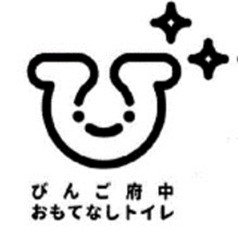 |
The toilets were constructed by means of “Subsidy Funding for Promoting the Smart Tourist Destinations Applying the Digital Technology”, which is provided by the Tourism Federation of Hiroshima Prefecture during 2020 and 2021. This funding aimed to develop the tourism infrastructure with the digital technology to be used for the sightseeing spots and tourist facilities. We thought the tourism demand must be recovered after the COVID-19 and everyone can enjoy sightseeing tours safely and securely without any stress.
[Introduction of the improved toilets]
(Ms. Yazaki) I will introduce five distinctive toilets that were developed by the subsidies from the Tourism Federation.
<Jinguji temple Hydrangea Toilet> (Completed on 19 September, 2021)
Jinguji temple holds the Hydrangea Festival every June time of the year.
The local volunteers planted many hydrangeas at Jinguji temple in order to make attract the tourists. A toilet was installed as many tourists increased to visit this temple.
A picture of Hydrangea is drawn on the wall of the toilet. This is a large picture like a mosaic that is formed by collected paintings one by one drawn by the children of the elementary school nearby. Hydrangea is a symbol flower of Fuchu City. In fact, this picture is an image of a great power gathering all participants. There is a gallery space where children’s drawings are exhibited throughout the year. The stained glasses are illuminated at night and creating a fantastic atmosphere.
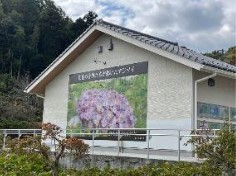 |
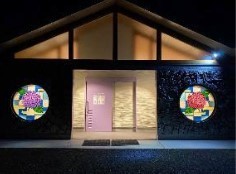 |
<Maple Forest Toilet at Fuchu Hachiman Shrine> (Completed in 2021)
It was built by the Executive Committee of Fuchu Hachiman shrine Maple Forest. Many hikers often visit there, but there was no hygienic flush toilet until then. There was only one temporary toilet. Then the local people requested to build a new toilet there. The locals came up with the idea of a transparent toilet pursuing a special attractive toilet. Light-control glass is attached to the partition of the toilet cubicle. The toilet is transparent before the door is locked, and the entire cubicle walls are whitish smoked after locked to use.
A video of Fuchu Hachiman Shrine is displayed over the whitish smoked glass wall. There equipped a pedestal style toilet and the automating the cleaning function against COVID-19. Bingo Fuchu Hachiman Shrine is famous for the beautiful with coloured leaves in autumn season. There is Kubinashi Jizo stature nearby and famous for its headless style sculpture.
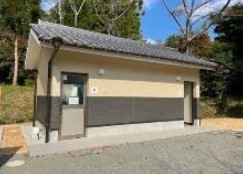 |
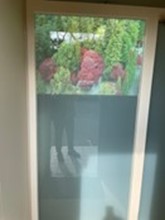 |
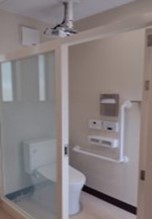 |
<Kyowa district tourist toilet>
A local artist painted a dragon on the front wall of the toilet and the earth on the ground. It is a trick art of the dragon grabbing the earth, and it looks like going to jump out at any moment. The visitors can get information on nearby sightseeing spots by capturing the QR code displayed on the information signboard on the side. This dragon painting is very popular among motorcycle riders through the social media, and they often stop by. This area is famous for the special paper production called Aji Japanese paper and the local people will try on the revival of it.
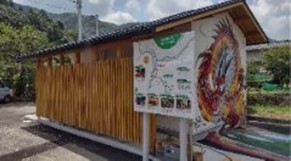 |
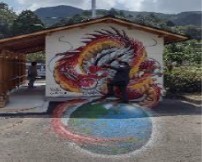 |
<Hokaisan Marche Toilet>
Hokaiyama Direct Sales Centre is located along the main road connecting downtown of Fuchu City and Joge Town. They sold vegetables in a simple building from about 30 years ago before the renovation. The inside store was very hot in the summer season. Furthermore, there were dangerous large steps on the concrete floor. The new store is for everyone including the tourists to stop by and can buy fresh local vegetables. We considered the store and toilets must be built applying with universal design for the local elderly staffs with feeling safe. Yano hot spring park Shiki-no-Sato and camping grounds are located around there. There is a sacred place called “Rainmaking Prayer Rock” which is told that a rainmaking prayer performed here long time ago.
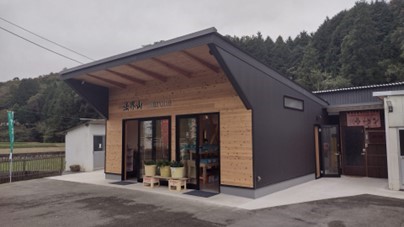 |
<Toilet at Joge town business association>
There was a public toilet for a long before, however it was in a dilapidated state with frequent breakdowns because it had been used for more than 30 years. The Joge town business association building which is registered as a national cultural property and the east area of the building with the white-walled townscape are attractive for the tourists. A new safe toilet is open all day and night for the wheelchair users, families, and many users.
The vertical lattice is adapted on the facade for matching to the townscape with the white walls. The lighting beautifully leaks through the vertical lattices at dark night. There are also hygiene management, such as an automatic washing tab as well as a multi-purpose toilet for the elderly people with applying digital technology. The digital technology such as an automatic temperature measurement system and the digital signage which introduces the local doll’s Festival.
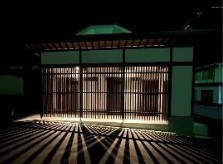 |
[Bingo-Fuchu Toilet Tourism]
(Mr. Okada) We call “Bingo-Fuchu Toilet Tourism” with the toilets and their surrounding tourist spots. Those toilets themselves are also introduced as part of the tourist attraction spot to cultivate the environment for the visiting tourists. Bingo-Fuchu Toilet Tourism has been featured many times in the public relations magazine of the city. The sanitary litter boxes are installed even in the men’s cubicles with marking “S” mark. This is also introduced in public relations papers. Fuchu City is trying to promote tourism by maximizing the potentials of toilets. We wish firstly to enhance tourism by means of the contents and promotions, and invite many travelers to visit here, and make them to feel cozy to become repeaters and introduce their good reputation to their friends or colleagues. I think it is important approach to let the more sightseers visit here.
I think it is important to give a good impression of Fuchu City not only with the tourism content but also with our hospitality.
A survey by the travelers revealed that the easy availability of toilets is a key factor by the visitors. Everyone can use “Bingo Fuchu Hospitality Toilet” comfortably and being systematically by means of the step-by-step improvement with the local people support. Those unique toilets have been once broadcasted on TV and gained good reputation. We still receive some positive feedback from many people who have used these toilets. We would like to show a good impression on Fuchu City region by the comfortable toilets for the visitors. This will create fans on this city by means of positive PR (public relations) and promote a tourist attractive point.
[Toilet in Children’s Country]
(Mr. Okada) There is a facility called “Fuchu City Children’s Country” in this City that combines a park and a children’s centre. Once there were no toilets in the park. Hiroshima Prefectural Government solicited nationwide proposal themes for the design planners with the university students and vocational students studying the architecture. The competition is called “Hiroshima Architectural Student Challenge Competition” and the best design work is to be built in actual. The theme of the competition in 2021 was “Bingo Fuchu City Children’s Country Toilet.” A plan of toilet in a park that is used all people including children, with a hall space inside so that parents can watch over their children, won the grand prize and it is under construction now. Since it is a toilet in a “Fuchu City Children’s Country”, which is used by 120,000 people a year, we would like to promote tourism, including it.
 |
(Kawauchi) Mr. Yamato of Amenity Co., Ltd., who is a member of the steering committee of the Japan Toilet Association, has been paying attention to this tourist toilet in Fuchu since long time ago.
(Mr. Yamato) My profession is a toilet maintenance work all over Japan. There is a project called “The Tokyo Toilet (TTT)” which is funded by Mr. Koji Yanai of UNIQLO and produced by the Nippon Foundation. It cooperates with Shibuya Ward in Tokyo to create several various types of the toilets with quite new concepts. My company also contributes for the toilet diagnosis and maintenance works for TTT.
Toilet maintenance costs a lot and must be taken seriously from the beginning. The Nippon Foundation and the Shibuya Ward Tourism Association discussed whether the toilets themselves could be a part of the tourism resources in order to cover the cost. The toilets of “The Tokyo Toilet” designed by the famous creators are built within walking distance. The students and families come to see them while taking a walk around.
I was looking at this situation, and thinking whether the toilet itself could become one of the tourism resources. At that time, newly built toilets in Fuchu City, Hiroshima Prefecture were featured by the newspaper. The article contained the term “Toilet tourism.” I was interested in the idea and I searched its website. I felt that their activities were quite attractive, then I decided to visit the place to observe their activities. I visited a toilet in the Kyowa district. There was an information board next to the toilet, and I felt that it would be a good initiative if it informs not only the location of this toilet but also the surrounding tourist information.
{Q&A}
[Q1.1: Ho] QR codes may provide the local information as one option as a tie-up between digital technology and toilets. It might also be interesting to use an AP to create a toilet QR stamp rally.(1) How often the frequency and cost of the toilet cleaning, the toilet paper replenishment, and the repairment?
(2) It is fun that each toilet has own characteristics, but is there any problems that the users may perplex to find the toilet location immediately because the toilet designs are quite different in each one?
(3) Have you confirmed the effect of increasing the number of the tourists by means of the construction of toilets?
[A.1.1: Ms. Yazaki] Daily cleaning and replenishment of toilet paper are mainly performed by the local community, but they request the city for maintenance. It is not easy to answer immediately about how to deal with the maintenance of toilets in the future as the city constraints the budget.
[A1.2: Mr. Okada] The entity that installed this toilet belongs not the city but each local group. The city provided subsidies under the condition that the local groups will take charge of maintenance.
[Q1.2: Kawauchi] If it is a product sales facility, a part of the profit can be applied for the maintenance. There is no profit from the toilet facilities, I think it is very important to prepare a maintenance system after the construction. The designs of each toilet are different and Fuchu City did not order it to them in a unified way but the local groups decided. I imagine they tried to make toilets matching to each place by their own ideas.
[A1.3: Mr. Okada]
There exists no uniformity because each design was done by the local groups. However, I have never heard of user complains that the toilet location is difficult to find as in your question 2, since they are all built along the road. On the contrary, I have often heard from the motorcycle riders that it is easy to find and stop by.
[A1.4: Ms. Yazaki] We did a tourist statistics survey but it is not certain about the toilet effect in Q.1.1.3. However, I have heard from local people that the users considerably increased after the renovation of the toilets. Many people come to take pictures and post them upon SNS. The number of people using the toilet itself is not included in the survey, but we are surveying of the tourist spots in the surrounding area.
[A1.5 Mr. Okada] I heard about the amount of use of toilet paper and the numbers of users are increased, but I don’t catch up the exact numbers.
[C2. Kawauchi] I have an impression that the local people will have a quite strong attachment to those toilets, because Fuchu City has subsidized the toilet in response to the requests of the local people.
[A2: Mr. Okada] For example, the hydrangeas at Jingu-ji temple are not solely planted by the temple but also by the local people in planting and managing the flowers. The local volunteers will also lead the tour buses during the blooming season. The city subsidized since there were requests from the local community that the toilets for visitors were seriously necessary.
[Q3: HI] There is a multi-purpose toilet in the “Bingo Fuchu hospitality Toilet.” What kind of toilet is it in reality? There is an introduction page in Bingo Fuchu Tourism Toilets of the website by the Fuchu City Tourist Association. There introduce six toilets, but there is no information on the facilities.
[A3: Mr. Okada] The information on the locations and facilities of not only these “Bingo Fuchu Hospitality Toilets” but also other multi-purpose toilets in the city have not yet been released. In fact, there are opinions that information on such facilities should be widely disseminated. Now we try to hold meetings on this matter involving with crossing the boundaries of city departments. We are currently collecting information on toilet facilities not only for this “Bingo Fuchu Hospitality Toilets” but also for other public facilities in the city, public halls, tourist facilities, nursery schools, and put into Excel sheet.
[C3: Kawauchi] In particular, multi-purpose toilet users require information not only about the toilet locations, but also equipped facilities. A couple of photos of the inside of the multipurpose toilet cubicle must be quite helpful.
[Q4: ONO] Did the citizens quickly understand the necessity of the “Bingo Fuchu hospitality Toilet”?
[A4.1: Mr. Okada] For example, once there was a tourist toilet in Joge town business association. However, they had to return the real estate to the owner since it was a leased and faced the problem of the lack of the public toilets eventually. There were different issues in each place. We happened to find a subsidy the Tourism Federation and we decided to apply to these places. I don’t think there was any opposition to build the toilets. The toilet issues have been kept long time besides the small budget of the city. There were usually key persons in each local community and consequently they well match with the ideas of the city.
[A4.2: Ms. Yazaki] At the same time, the Hiroshima prefectural office had sent a manager in charge to the city’s tourism division, and making it easy to use the prefecture’s subsidies fortunately.
[A4.3: Mr. Okada] The prefectural government is also promoting a campaign called “Hospitality Toilets in the Tourist Spots” and we got an idea from the manager that toilets in tourist spots must be an important factor.
[Q5: Kawauchi] I don’t think Fuchu City has that many tourism resources.
[A5.1: Mr. Okada] The city did not simply focus on the tourism since it is originally a commercial and industrial city. Conversely, it can be said that it is new chance to cultivate of a new field. In fact, there are rarely conspicuous tourism resources, we tried to use various materials for the tourism resources as much as possible including the toilets.
[A5.2: Ms. Yazaki] There is a phrase; “Fuchu city will cultivate the tourism to be one of the industries that support the city” in the tourism promotion vision created in June 2020. There is a trend to focus on the tourism in Fuchu city as a traditional industrial structure transformation.
[Q6: ONO] Please let me know the subsidy rate over the total project cost.
[A6: Ms. Yazaki] Four-fifths of the total project cost is subsidized by Hiroshima prefecture. It additionally includes the digital signage in the toilets.
[Q7: Kawauchi] Is there something digital methods about the toilet itself?
[A7: Mr. Okada] For example, the smoky glass walls, automatic flushing functions, and showing tourist videos in toilets.
[C8: HI] Wheelchair users wish to know in advance whether the handrail is put on the left or right side. They also want to know if there is a backrest with the toilet bowl in the toilet cubicle.
[C9: HO] I think it will be necessary to calculate the figures such as the number of users to check whether Fuchu City’s toilets project is succeeded or failed.
[Q10: Kawauchi] Can I understand that Fuchu City is mainly responsible for the advertising, and that the toilets are managed by the local people?
[A10: Ms. Yazaki] Fuchu City is responsible in the role of posting in public relations (PR) and appealing the concept of the sightseeing toilet tourism. We cannot cover the maintenance system of each local area, since the maintenance must be responsible by the locals.
[Q11: Kawauchi] Is the maintenance done by the professionals or by the local volunteers?
[A11: Ms. Yazaki] It is mainly done by the local volunteers.
[Q12: Kawauchi] This method will be fine during the toilet is still new, but it will be necessary total cleaning someday. I feel that current way won’t last long without a proper maintenance system. Are there any problem of the vandalism occur in those toilets?
[A12.1: Ms. Yazaki] It’s been about one year passed since all completed, but so far, and any serious problems have not occurred.
[A12.2: Mr. Okada] For instance, the problems such as the theft of the toilet paper may have occurred in other toilets than these five hospitality toilets, but we haven’t really considered much about the countermeasures. There are the toilet cleaning companies in the city, but maintenance is done by the local volunteers and Senior Human Resource Centre staffs who clean them once a week without any quality specifications. We recognize that it is the following issue as we could not think well about the maintenance just after the completion.
[Q13: Kawauchi] At the beginning of today’s presentation, there found few pedestal style toilets at the tourist facilities in Fuchu City. Is there any plan to convert all toilets for the tourists this time with the pedestal styles?
[A13: Mr. Okada] There are no plans, but the five hospitality toilets introduced today are all with the pedestal style ones, reflecting the feedback from the local requests.
[Q14: HO] Is this project finished? Or do you still plan to continue?
[A14.1: Mr. Okada] We cannot expect any longer possibilities to utilize the tourism federation’s subsidies, since the subsidies have already completed.
[A14.2: Mr. Yazaki] So far, we have no plan to increase such distinctive toilets.
[Q15: Kawauchi] Have you received any reputational letters to the city as a reaction about the toilets from users?
[A15: Ms. Yazaki] There were some inquiries over the phone, just after it was nation-widely broadcasted by NHK. We received a postcard saying that they will support to a wonderful initiative being carried out by the locals.
[C16: Kawauchi] The main point must be the essential attractiveness of the tourist spots. I suppose even if the impressive toilets attract the visitors at first step, the repeaters will not visit there again otherwise the main tourist spot is less attractive.
[C17: SI] I’m conducting toilet tours. Many governments try to spotlight their toilets. I think the Japan Toilet Association can support to connect with users and the local governments. It is discouraging that if the person in charge changes, or their enthusiasm cools down or neglects after the completion. I believe it is important to try to continue the activities.
There are two dirt types of the cleaning. One way is to be cleaned by the volunteers. The other way is to be cleaned by the professionals. If it is treated well in advance, it will not be badly soiled afterwards. In some cases, volunteers scratch too much the toilet bowl surface while cleaning, then afterwards the dirt can hardly be removed. This means there are limitations in the responsible roles where the local volunteers can do or should do on the toilet maintenance. The attractive information on the toilets is necessary, but I think it is also necessary to provide the emergency response information such as the countermeasures when toilets become unusable at a disaster to the local people who must manage them.


